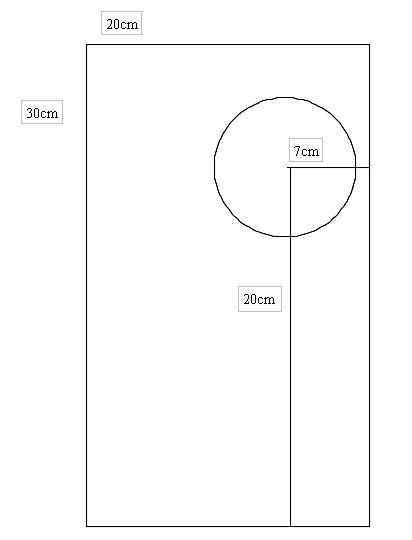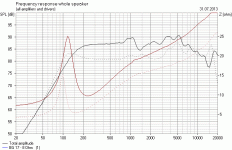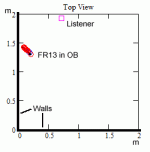Hello xrk971,
With one speaker the baffle are as this:

How should it be whit two speakers?
Regards
You can cheat by telling the simulation software (if that is what you are using to develop the baffle ) that the two drivers are just one with equivalent Sd x 2 located at midpoint between the two. Probably have to increase baffle height by at least dia of driver and mount so middle is at same 20 cm location. If you have some cardboard or foam core - test it first on that it will work fine to help isolated the front and back waves. When you find what sounds good in cardboard then cut wood.
I can easily simulate up to 8 drivers on that baffle, but I can't show the mess they will deliver when listened to from 1-2 m distance - as would be the case for raul_77.You can cheat by telling the simulation software (if that is what you are using to develop the baffle ) that the two drivers are just one with equivalent Sd x 2 located at midpoint between the two.
And no - the whizzer cones would never move to the midpoint between the two drivers. They will stay at least 13 cm apart forever.
When was the last time you saw two tweeters spaced 13 cm apart in a speaker 😕
Rudolf
Hello Rudolf, thank you very much for your kind andswer.
Well. Yes. One speaker only. Your design with the Visaton are very good, just the kind of speaker I'm looking for, pity not get into 8 Ohms.
I hope someone put some design more, I would like to choose, but if they appear other is likely to also build yours. It's good, nice and cheap.
Regards
Well. Yes. One speaker only. Your design with the Visaton are very good, just the kind of speaker I'm looking for, pity not get into 8 Ohms.
I hope someone put some design more, I would like to choose, but if they appear other is likely to also build yours. It's good, nice and cheap.
Regards
With 3 or 4 inch drivers, line arrays are used all the time with good results. You are right about 2 whizzers being problematic - comb interference etc when not close together. Maybe cut the whizzer of of the bottom one? In any event they are cheap and cardboard baffles are free for one to experiment with.
What about this? 8 Ohms, 93dB, 6,5" and say that are good for open baffle.
http://www.parts-express.com/pe/showdetl.cfm?partnumber=292-546
A design, please?
Regards
http://www.parts-express.com/pe/showdetl.cfm?partnumber=292-546
A design, please?
Regards
Same baffle, same position, same EQ, but BG 17-8:What about this? 8 Ohms, 93dB, 6,5" and say that are good for open baffle.

Dashed lines are the FR 13-4. Brown is impedance. I listened to a single BG 17 in OB for two hours and put it back into its shipping carton. A hopeless case ...
You can always put a 2 Ohm resistor in front of the FR 13 if you fear for your 8 Ohm amp.
Hello Rudolf, thanks again.
So, best the FR13. No, I don't fear for the amp, with the BD131/132 no problems, but add a 2 Ohms resistor in series decreases sensitivity, and 88dB are not much for 5W.
Kind regards
So, best the FR13. No, I don't fear for the amp, with the BD131/132 no problems, but add a 2 Ohms resistor in series decreases sensitivity, and 88dB are not much for 5W.
Kind regards
Go with the dual drivers FR13 and you get 91 dB sensitivity don't worry about the two tweeter problem it will be fine for near field. If it doesn't work you have a spare set if drivers for another OB or another project and it sets you back $20. I run two 3.5 in drivers next to one another and I think it sounds great.
Hello xrk971,
I have no problem in experimenting. But, please, can you post a explanation, or best a drawing, with the dimensions of the baffle and speaker placement also?
Regards
I have no problem in experimenting. But, please, can you post a explanation, or best a drawing, with the dimensions of the baffle and speaker placement also?
Regards
I will have figure out how to model and simulate an OB first and get back to you. I can model enclosures, horns, TL's, etc but have not yet done an OB. Maybe it is time to start.
look for old consoles 90% of them are open baffle design.
No, actually not. They are U-frames, which at least helps lower the bass cut-off a little.
The thing is, in order to get anything that approaches bass out of an OB requires either a baffle measured in feet, not inches, or a bass driver with enough excursion to handle massive EQ. Add to this, the implementation is to be a desktop with the speakers hard against the wall. That prevents the dipole pattern from developing. A desktop OB is an oxymoron.
Bob
AkAbak sim of OB
I am not sure if I did this right as first time modeling an OB. I modeled it as a short duct (depth of baffle material 18 mm) and with a baffle diffraction size determined by OB baffle dimensions with driver placed at offset locations. The front wave is a direct radiator and the back wave reflects off the back wall. The combined wave is the superposition of the two waves and this cancels out a lot of the bass. The larger the baffle is, the less cancellation.
Anyhow, I tried it with the two FR13's in a large baffle (60 in tall x 36 in wide) placed 60 in from back wall, driver centroid is offset horizontally from center of baffle by 12 in and 20 in vertically (up) from center of baffle. First plot shows that you do get some bass.
Second plot is using a single driver in the tiny baffle of 20 cm wide x 30 cm tall set at 24 in from back wall as typical on a desk. There is so much cancellation of front and back wave that there is no bass. The freq response is just awful. You are better off with sealed cardboard box. Not kidding.
Third plot is impedance of large baffle, fourth plot is driver cone excursion with large baffle. Last plot shows what happens when you don't put any offset on drivers - the front and rear waves cancel and the bass collapses.
I may have done this wrong, if someone familiar with OB response can let me know if this looks OK?
It is very easy to add as many drivers as I want of any sort at any location if this is good approach.
I am not sure if I did this right as first time modeling an OB. I modeled it as a short duct (depth of baffle material 18 mm) and with a baffle diffraction size determined by OB baffle dimensions with driver placed at offset locations. The front wave is a direct radiator and the back wave reflects off the back wall. The combined wave is the superposition of the two waves and this cancels out a lot of the bass. The larger the baffle is, the less cancellation.
Anyhow, I tried it with the two FR13's in a large baffle (60 in tall x 36 in wide) placed 60 in from back wall, driver centroid is offset horizontally from center of baffle by 12 in and 20 in vertically (up) from center of baffle. First plot shows that you do get some bass.
Second plot is using a single driver in the tiny baffle of 20 cm wide x 30 cm tall set at 24 in from back wall as typical on a desk. There is so much cancellation of front and back wave that there is no bass. The freq response is just awful. You are better off with sealed cardboard box. Not kidding.
Third plot is impedance of large baffle, fourth plot is driver cone excursion with large baffle. Last plot shows what happens when you don't put any offset on drivers - the front and rear waves cancel and the bass collapses.
I may have done this wrong, if someone familiar with OB response can let me know if this looks OK?
It is very easy to add as many drivers as I want of any sort at any location if this is good approach.
Attachments
Last edited:
I've been running a PC OB system for a year or so now and it sounds pretty good. It uses the Tang Band "bamboo" 3 and a 10" .7 qts, 30 Hz fs woofer. The baffles flank the monitor, about 2 ft in front of the wall. I ended up putting a Dayton 18" pro steel basket woofer under the monitor in slot vent intending to run an active sub but found it worked great as a passive radiator. Anyway, the system's high point is definitely the bass. You just can't sit too far away from the monitor and expect flat response. Crossover is at 240hz, and there is 6db oct compensation on the 10's. One time I set the system up on a corner desk. Now That was a joke. It sounded really, really bad.
The 18 is actually for another project entirely and will be leaving from under the monitor soon.
The 18 is actually for another project entirely and will be leaving from under the monitor soon.
Last edited:
The 10 in woofer helps a lot. I will stick that in the sim to see if things improve. Do you have photos Andrew Eckhardt?
No but I should probably shoot one so everyone can see what I'm talking about. Probably tomorrow.. The sound really isn't too shabby. The sound card is the weakest part of it..
I have tried to simulate this situation for the left speaker (I don't recommend to have the OB pushed into a corner like the right one). This is the top view:What I look for is something like this:


The OB is almost against the back wall, toed in 45°. The listener is the red square. Floor level is the desktop. The simulation worksheet from www.quarter-wave.com can't simulate different levels in a room. The simulation includes reflections from the front wall, left side wall, ceiling and desktop.
This is a comparison of the free air response (blue) and the response in the situation explained above:

The simulation lacks the resistor in parallel to the coil. The MJK worksheet provides simple crossovers only.
Everybody is entitled to call a desktop OB an oxymoron. 🙄
This is the proof 😉.
Thank you very much to all!
Any more design, please? Until now only Rudolf have been posted one. Thanks Rudolf!
I have two Tang Band W4-1052SA stored in their boxes without using. Can be used in a open-baffle? How?
Regards
Any more design, please? Until now only Rudolf have been posted one. Thanks Rudolf!
I have two Tang Band W4-1052SA stored in their boxes without using. Can be used in a open-baffle? How?
Regards
Last edited:
.Until now only Rudolf have been posted one.
Not the only one. Post #34 shows the simulation of your 20 cm x 30 cm OB design with an FR13. It doesn't look good. OB needs to be rather large to work, of order 1 meter before any bass can be heard.
- Status
- Not open for further replies.
- Home
- Loudspeakers
- Full Range
- Small open-baffle?




